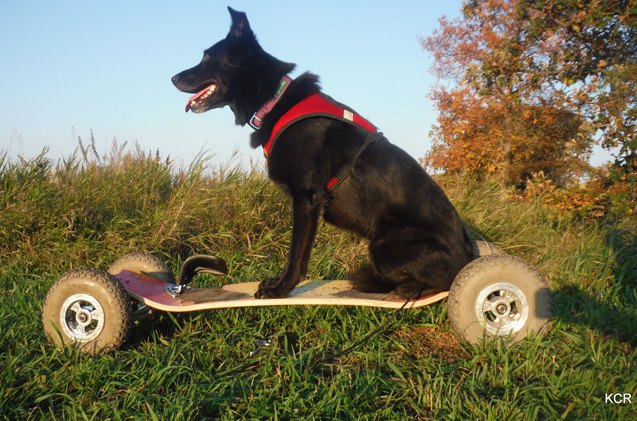Mountain Boarding With Dogs: Off-Roading Adventures Powered By Pooches

Kevin Roberts finally gets his feet on a mountain board – and suffers a hard break. Here’s what he learned from his spills and thrills, and what you need to know if you want to try it with your dogs.
The very thought of mountain boarding with my dogs had been the focus of my dreams and online window shopping habits for months. I knew the specs of every mountain board in production by heart. I made eBay my homepage. I was saving pennies and counting down the days until I could get my hands on a brand new mountain board of my very own.
The day I had been obsessing about finally came. When my mountain board arrived, I picked it up at the post office and loaded the dogs in the truck. The snow had melted recently, and I headed out to a dry trail. I hooked up the dogs, and strapped my feet into the board – I fastened my feet to the board using giant straps of Velcro, ensuring a secure fit.
Related: Mountain Boarding With Dogs Part 1
One would think this is a good idea, a smart idea, a safe idea. One would be wrong. As soon as we got started, I rolled over the tiniest bump on the trail, lost my balance and face planted. Hard. On the dirt trail.
Never one to be discouraged by a small mouthful of dirt, I shook myself off, got up and went for it again. The second time is the charm, right? This time, I kept my knees bent and put more pressure on my back leg. We were really moving now, so I started to carve the board a little behind the dogs. I looked down at the wheel, and in slow motion, I saw the stick bounce up from the front wheel, and catch on the back wheel.
The board stopped suddenly. I did not. I let go of the dogs, and my body went one way, and my feet went another. The board twisted and snapped. When I landed, I looked down at my broken ankle. The board was still strapped on.
Related: Getting Started In Skijoring
So I waited and healed. While my ankle was mending, I contacted the mountain boarding experts at Pawesome Dogs (the guy who posted the original video) and told him about my lackluster first experience.
The first thing he told me – NEVER strap yourself to the board (so that’s where I went wrong)! The reason being, when you are strapped to the board, you have no way to safely bail. By forgoing the straps while you’re on the board, if you need to bail, you can simply run off the front… and this way, you stay upright (and not face down in the dirt with a bum ankle).
What can I say – some of us learn things the hard way!
After this eye-opening conversation, I took the bindings off the board, and installed a skyhook (it’s pretty much a big hook that you can slide your foot under). No more strapping myself in! The next time I went out with the dogs, I was able to perfectly dismount by running off the board instead of breaking any more bones.
I also made the wise choice of switching to a hands-free walking belt when I mountain board with the dogs. When they are connected to my waist, instead of holding the line in my hands, it lowered my center of gravity and gave me better balance.
Now that I’ve perfected my mountain boarding skills and have a plan of attack, the dogs and I hit up local trails. We keep a pretty decent speed, enough that I can still kick along. I get my board time, my dogs get exercise and we all come home happy and safe!
If you are thinking of mountain boarding with your dogs, here are a few things to keep in mind:
- Teamwork. Dogs and human work together on the mountain board. You need to take the board out without the dogs at first, until you are comfortable working the brake, and kicking along the ground to get it moving. Once you get a feel for what you are doing, then add the dog component.
- Mountain boarding is dangerous. A helmet is mandatory, but knee pads, wrist guards and elbow pads are a smart idea.
- Do not attempt this with untrained dogs. Your dog should be obedience and mushing trained. Mountain boarding is going to take some skill and communication between you both.
- Look for the right board. The board should be made for your riding level and weight range. There are beginner boards to expert to choose from. Don’t be a hero or showoff – stick to your level. As well, consider thinner wheels (thinner wheels equal less friction).
- Buy a board with a handbrake. It’s pretty much like a bicycle brake that you hold in your hand, which helps slow you down. However, you shouldn’t rely on the brake to slow you down.
- Stick to a decent trail. Never run your dogs on pavement or uneven ground. If you avoid peak times of day, you will have less to worry about in terms of other trail users.
Learn from my mistakes, take it slow, and talk or train with someone who has mountain boarded with their dogs before taking the path less traveled. Once you try it, you’ll become addicted… trust me!

Kevin Roberts lives for adventure. Together with his pack of rescue dogs and his husband, he spends as much time outdoors as possible. Kevin lives by the motto: "Get outside and play with your dogs!
More by Kevin Roberts
























